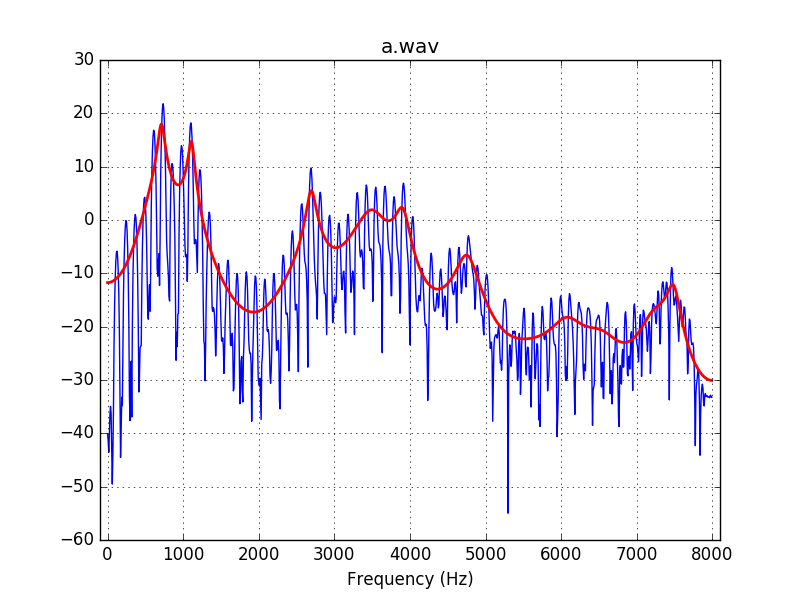こんにちは。
「線形予測分析(LPC)(Pythonで音声信号処理(2011/05/14)の第20回目:LPCスペクトル包絡を求める)」(= formant 分析)という記事を見つけたので、そこのコードをほぼそのまま動かしてみました。母音「あ」の例です。

走らせたコードは、そこに置いてあるそのままなのですが、書いておきます(levinson_durbin.py もそこから取ってきました):
- なお「Python(NumPy, SciPy)でフォルマント分析を行う」という記事でもこれを利用しているようです。
- 母音の音声ファイル a.wav もどこからか入手しました。
# coding:utf-8
from __future__ import division
import wave
import numpy as np
import scipy.io.wavfile
import scipy.signal
import pylab as P
from levinson_durbin import autocorr, LevinsonDurbin
"""LPCスペクトル包絡を求める"""
def wavread(filename):
wf = wave.open(filename, "r")
fs = wf.getframerate()
x = wf.readframes(wf.getnframes())
x = np.frombuffer(x, dtype="int16") / 32768.0 # (-1, 1)に正規化
wf.close()
return x, float(fs)
def preEmphasis(signal, p):
"""プリエンファシスフィルタ"""
# 係数 (1.0, -p) のFIRフィルタを作成
return scipy.signal.lfilter([1.0, -p], 1, signal)
def plot_signal(s, a, e, fs, lpcOrder, file):
t = np.arange(0.0, len(s) / fs, 1/fs)
# LPCで前向き予測した信号を求める
predicted = np.copy(s)
# 過去lpcOrder分から予測するので開始インデックスはlpcOrderから
# それより前は予測せずにオリジナルの信号をコピーしている
for i in range(lpcOrder, len(predicted)):
predicted[i] = 0.0
for j in range(1, lpcOrder):
predicted[i] -= a[j] * s[i - j]
# オリジナルの信号をプロット
P.plot(t, s)
# LPCで前向き予測した信号をプロット
P.plot(t, predicted,"r",alpha=0.4)
P.xlabel("Time (s)")
P.xlim((-0.001, t[-1]+0.001))
P.title(file)
P.grid()
P.show()
return 0
def plot_spectrum(s, a, e, fs, file):
# LPC係数の振幅スペクトルを求める
nfft = 2048 # FFTのサンプル数
fscale = np.fft.fftfreq(nfft, d = 1.0 / fs)[:nfft/2]
# オリジナル信号の対数スペクトル
spec = np.abs(np.fft.fft(s, nfft))
logspec = 20 * np.log10(spec)
P.plot(fscale, logspec[:nfft/2])
# LPC対数スペクトル
w, h = scipy.signal.freqz(np.sqrt(e), a, nfft, "whole")
lpcspec = np.abs(h)
loglpcspec = 20 * np.log10(lpcspec)
P.plot(fscale, loglpcspec[:nfft/2], "r", linewidth=2)
P.xlabel("Frequency (Hz)")
P.xlim((-100, 8100))
P.title(file)
P.grid()
P.show()
return 0
def lpc_spectral_envelope(file):
# 音声をロード
wav, fs = wavread(file)
t = np.arange(0.0, len(wav) / fs, 1/fs)
# 音声波形の中心部分を切り出す
center = len(wav) / 2 # 中心のサンプル番号
cuttime = 0.04 # 切り出す長さ [s]
s = wav[center - cuttime/2*fs : center + cuttime/2*fs]
# プリエンファシスフィルタをかける
p = 0.97 # プリエンファシス係数
s = preEmphasis(s, p)
# ハミング窓をかける
hammingWindow = np.hamming(len(s))
s = s * hammingWindow
# LPC係数を求める
# lpcOrder = 12
lpcOrder = 32
r = autocorr(s, lpcOrder + 1)
a, e = LevinsonDurbin(r, lpcOrder)
plot_signal(s, a, e, fs, lpcOrder, file)
plot_spectrum(s, a, e, fs, file)
return 0
if __name__ == "__main__":
file = "a.wav"
lpc_spectral_envelope(file)
exit(0)